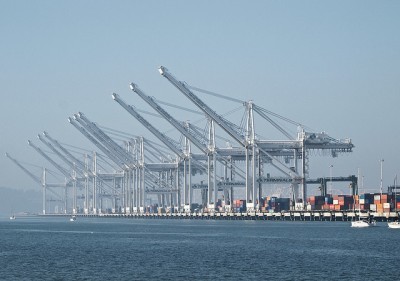
What does the FREIGHT Act really mean for our freight and ports?
 |
| Port of Oakland originally uploaded by ingridtaylar |
There were a few questions bouncing around via Twitter and elsewhere about the new FREIGHT Act introduced yesterday by Senators Lautenberg, Murray and Cantwell. We issued a joint press release with a few other groups, but it’s worth spelling out in plain language some of the benefits of the bill.
For context, it’s worth understanding how freight transportation policy currently works now to understand how much of an improvement this bill would provide.
Today, there is no national freight program or specific national policy. There’s no dedicated federal transportation money that states, regions or ports can spend to improve throughput or operations at ports, intermodal facilities and freight corridors. And among the traditional federal transportation programs, freight rail projects in particular (much like passenger rail) aren’t eligible projects.
So if a port is congested or wants to expand, there’s little available federal money to spend directly on rail or any other mode. Your choices are highways or highways. When a state or port does spend to improve operations, there is no accountability to make sure they’re actually reducing port/freight congestion, moving freight faster, or reducing air pollution in surrounding communities — a significant issue of environmental justice.
Under this new bill, there would finally be a coordinated national policy for freight and ports across the country, and for the first time public health and air quality surrounding freight hubs and facilities become strong criteria for awarding dollars.
No matter what ports decide to spend money on to improve their operations, they’d have to consider air quality, greenhouse gas reductions, and noise and water pollution in the surrounding communities with future federal investments. On top of that, there would be a merit-based grant program for projects that do the best job of improving freight operations while using money most effectively and hitting the benchmarks laid out in the bill.
Benchmarks? The goals in the bill set a powerful framework for accountability, spelling out what they money should accomplish, so taxpayers can know that their money is being spent wisely.
- Reduce delays of goods and commodities entering into and out of intermodal connectors that serve international points of entry on an annual basis.
- Increase travel time reliability on major freight corridors that connect major population centers with freight generators and international gateways on an annual basis.
- Reduce by 10 percent the number of freight transportation-related fatalities by 2015.
- Reduce national freight transportation-related carbon dioxide levels by 40 percent by 2030.
- Reduce freight transportation-related air, water, and noise pollution and impacts on ecosystems and communities on an annual basis.
For example, a port in a coastal city in California would have to consider the impacts on the health of those communities surrounding the port. Would investing in more freight rail capacity ease congestion, lower overall emissions, and reduce local air pollution? These are the kinds of questions that would have to be answered.
“A truly multimodal national freight program that is accountable to measurable performance targets and benchmarks is something the U.S. has needed for a long time,” said James Corless, director of Transportation for America in our press release.
“We applaud Senator Lautenberg for recognizing that our freight system can move our goods from coast to coast and power the economy while also being part of the solution for many of our most pressing problems: air quality, dangerous emissions, oil dependence, and congestion on our highways and interstates, to name just a few.”



